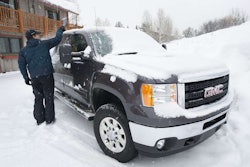National Tire Research Center Ready To Roll
GM contributes $5M toward facility that is said to revolutionize tire technology and design; state-of-the-art testing equipment replicates real-world driving conditions
 The National Tire Research Center’s state-of-the-art performance test equipment can run a tire up to 200 mph. It provides data on handling, ride, torque, and braking capabilities on various surfaces including wet road conditions. General Motors was instrumental in developing the machine’s test specifications.
The National Tire Research Center’s state-of-the-art performance test equipment can run a tire up to 200 mph. It provides data on handling, ride, torque, and braking capabilities on various surfaces including wet road conditions. General Motors was instrumental in developing the machine’s test specifications.
General Motors’ drive to improve vehicle fuel economy is expected to gain traction in January when GM engineers and scientists begin work with research partners to accelerate the development of tire technology at the new National Tire Research Center in Halifax County, Va.
The world-class facility, to which GM contributed $5 million, uses state-of-the-art tire performance machinery that will enable automakers and tire manufacturers to replicate real-world emergency events and improve vehicle highway safety.
By some estimates, tire design can help improve fuel efficiency by up to 7 percent.
A tire’s rolling resistance is determined by variations in tread pattern, construction, material quality and processing techniques. Ultimately, the lower the rolling resistance, the less fuel is needed to move the vehicle forward.
Low rolling resistance tires are expected to help customers save money at the gas pump, as will more efficient conventional engines and electric powertrains.
“The work we’ll undertake at the National Tire Research Center will have a big impact on how quickly next-generation tire technologies will be developed and the accuracy of their design and engineering,” said Ken Morris, GM’s executive director of Global Vehicle Performance and Safety, and proving grounds and test labs.
The center’s $11.2 million tire performance test equipment, known as Flat-Trac LTRe, is unique in its use of electric motor technology and can run a tire up to 200 mph.
It provides data on handling, ride, torque, and braking capabilities on various surfaces, including wet road conditions. GM was instrumental in developing the machine’s test specifications.
The Flat-Trac LTRe is capable of replicating all driving maneuvers of a passenger car or light truck on the road. GM and other automotive engineers will be able to use the data collected by the equipment to predict vehicle performance and modify tire characteristics to improve performance for low rolling resistance, better road-holding capability and other criteria.
“This facility’s test equipment is like going from a basic telescope to the Hubble – it opens up a whole new world of possibilities,” said Frank Della Pia, a former GM vehicle dynamics manager who is executive director for the tire research center.
“It can test tires in the full range of the performance spectrum. This facility has no peer in the world. It’s going to enable a transformational leap in tire technology.”
The center’s facilities also include the Southern Virginia Vehicle Motion (SoVa Motion) Laboratory, strategically located in the heart of the Virginia Motorsports Alley at the Virginia International Raceway.
SoVa Motion offers shock and suspension testing, virtual prototyping of vehicle components, and a range of on-vehicle sensing such as wheel force transducers. SovaMotion will take advantage of the Tire Center’s test data to conduct drive and handling simulations that could help reduce time and cost of vehicle program development.
“The work GM will do with SovaMotion and the National Tire Research Center will further improve laboratory test methods and improve our overall vehicle development process,” Morris said. “Ultimately, that means better vehicles for our customers.”








